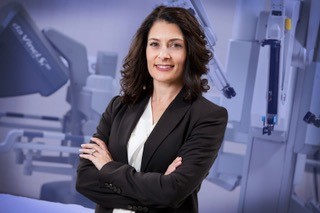Patients have less pain, quicker recovery thanks to robotics
October 8, 2019
See how NCH helps patients with female problems

Originally published in Northwest Quarterly Magazine by Lindsey Gapen Lukas
The days of robotic surgery being “new” are over, especially in gynecology.
The FDA approved the first medical robot in 2001 for urology, and then in 2005 the da Vinci robot was approved for gynecology, says Dr. Michelle Luthringshausen, director of robotics at Northwest Community Healthcare (NCH). She’s been doing robotic surgeries since early 2007.
“We’re now on the third-generation robot, and there have been many improvements over time with the optics and capabilities based on surgeons’ feedback,” she says.
When Luthringshausen started at NCH in 2011, the hospital only had one da Vinci robotic system. Now, there are three, and the robotics program has gone from about 15 physicians and surgeons to more than 40. The surgeries cover a range of specialties, from urology and gynecology to general surgery. Luthringshausen makes sure the entire robotics program runs smoothly and safely.
She also does benign gynecologic procedures, so any procedure related to the female reproductive system that doesn’t involve cancer. This could be the removal of painful ovarian cysts, the removal of painful tissue and scar tissue for women with endometriosis, hysterectomy procedures, and much more.
“Really almost any surgery that’s in the pelvis can be approached robotically,” Luthringshausen says. “And what’s nice about robotics is that it’s taken laparoscopic surgery and made it accessible to everyone of all body types. The robotic instruments free up the surgeon’s hands – it gives us four hands, basically. So, we can do more-complex things for a wider range of patients.”
From a patient perspective, preparation for robotic gynecologic surgery isn’t different from other minimally invasive surgeries. Patients must refrain from eating or drinking after midnight prior to the day of surgery, and occasionally, the patient may need to consume a solution to clean out their bowels. On the day of surgery, it’s just a matter of undergoing general anesthesia.
From there, the surgeon makes an incision at the base of the patient’s belly button and introduces carbon dioxide, which makes a pocket of air inside the abdominal and pelvic cavities so that there’s room to operate.”
“There isn’t a space there, so we have to create a space so that we can put our instruments inside to operate,” Luthringshausen explains.
Once the carbon dioxide is inside the patient, the surgeon can put a camera into the belly button. The surgeon then makes other incisions that are less than a half an inch in size to help make room for other necessary instruments, such as the cannulas, or “metal straws” that attach to the arms of the robot. Once all the instruments are inside the patient and the robot is docked, the surgeon sits at a separate console, places her head into the upper console to view the surgical area, and uses hand controls similar to joysticks to control the robot.
The 3-D view is impeccable.
“It’s as if I were standing inside the patient’s abdomen,” Luthringshausen explains. “I have full range of motion in my wrists, which you don’t have in straight laparoscopy. So, that’s why robotic surgery allows you to do more-complicated things, and you have better visualization.
“Basically, it’s a platform that makes you superhuman as a surgeon.”
Robotic gynecologic surgery typically takes around an hour and a half to complete, but more-complicated surgeries may take up to 5 hours. Most of the time, after the patient recovers from anesthesia, they get to go home within 3 to 4 hours.
“That’s an advantage – the recovery is so quick,” Luthringshausen says. “Most patients don’t need narcotics or pain control after the first 72 hours because there’s less damage and bruising to the abdominal wall. Patients get out of the recovery room faster and return to normal life faster than after typical surgery.”